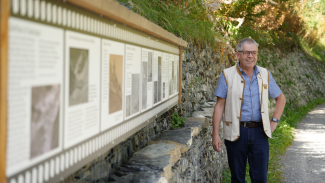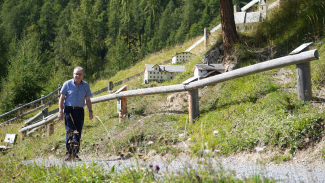Turning hobbies into a profession.
Samnaun expert Arno Jäger

With a huge ski area or attractive duty-free shopping opportunities, the hospitable Samnaun knows how to inspire. Far away from the big and modern hustle and bustle, the village in the very east of Switzerland also impresses with its unique cultural history. The first place to go in the valley to find out more is the Chasa Retica. The over 450-year-old building in Samnaun-Plan now houses the valley museum. Now and then its ladder greets you, propped up on the double-hinged door - open at the top, it used to be comfortable to chat with neighbours, while the closed half at the bottom provided a barrier for animals. With a broad smile, Arno Jäger welcomes interested visitors. But the people in the valley were not always received in such a friendly manner.

Long winters and hard times
About 1000 years ago, farming families from the Lower Engadin were looking for new pastures. They found what they were looking for in the Samnaun valley, as the Rhaeto-Romanic field names still testify today. It seemed to be an ideal area for agriculture. The special climate allowed the cultivation of grain up to 1800 m above sea level, which was only possible up to 1450 m in the Engadine. But what today is a real blessing for snow sports enthusiasts was quite a curse back then: the winters, which lasted about half a year. They cut the valley off from the environment and made for a poor, deprived life.
The Samnauner*innen set out 200 to 400 years ago in the Tyrol in search of marriage – their only chance of survival and also the origin of their present dialect.
Arno Jäger
In addition, various disputes arose from 1529 with the beginning of the local Reformation, because Samnaun, like the Tyrol and in contrast to the Engadine, remained largely Catholic. In 1621, during the Bündner Wirren, Archduke Leopold invaded Graubünden with 8000 men, plundering. Battalions also reached Samnaun in 1621 and 1622, plundering and driving away a large part of the livestock. Plague and cholera later did the rest, and for their survival the Samnaun population developed strong ties with Austria, including trade relations. Over time this led to the Samnaun dialect, which replaced Romansh. Samnaun did not become a municipality in its own right until 1806, before which it belonged to neighbouring Ramosch. These are just some of the key points of the exciting history of the valley that Arno Jäger knows how to tell.

Attachment to the village
Arno's story began in Samnaun. It led him on to an apprenticeship as a baker-confectioner in Sent and then to the kitchen of the Hotel Rezia, today's Pensiun Aldier. At the age of 20 he returned to Samnaun and opened his own business, a café and shop that no longer exists. Along the way, with only a brief interruption, he shaped politics and life in the valley for 21 years as a local councillor with a focus on building and environmental issues. He looks back with pride on the successes he achieved through project collaboration or management. These include, for example, the expansion of the water supply to today's level, the centralisation including the new construction of the forestry/works yard or the construction of the Chalamandrin senior citizens' centre. Today, he is still responsible for property management in the parish.
For me it's like a symbiosis: Samnaun with its landscape and the almost familial relationship with other people in the village gives me a lot – I like to give something back.
Arno Jäger

Small but mighty
Those who set off from Samnaun-Compatsch on the barrier-free culture trail are accompanied on the hike in an entertaining way. There is information to be discovered about agriculture and the history of Samnaun or a photo exhibition by Samnaun photographers. A special jewel are the small model houses on a meadow at the side of the path. They were built by Arno in meticulous detail and are true-to-life replicas of the first inns in the Samnaun valley. As president of the cultural commission, he has invested a lot in the culture trail and also runs the valley museum against this background. He offers weekly guided tours and even cooks here afterwards as he did in grandmother's time. Bringing the valley closer to the people is his goal, and he does everything he can to transport them back to another time for an authentic experience.

Many hardworking helpers
During the summer months, Arno can be found almost daily at his favourite place in the valley. At Prasüras, located directly on the Austrian border, there is bustling activity under his control. Thousands of bees are busy collecting nectar from the surrounding mountain meadows. Around 20 colonies live in the beehives that are lined up around the two wooden hives he built himself in the meadow. Depending on the weather, 10 to 20 kg of honey can be produced per colony per year. In late summer, Arno can start harvesting. The fine honey can be bought in selected shops in Samnaun. It is obviously in great demand, because even bears gained unauthorised access to his precious commodity a few years ago.
It's not only bipeds that enjoy my honey. In 2012, the bear brothers M13 and M14 raided my beehives twice, paying no attention to the closed door.
Arno Jäger

Commitment in and beside the spotlight
While the bees get his attention in summer, he devotes himself to another affair of the heart in winter: the theatre stage. The Samnaun theatre group puts on a play every week from Christmas to Easter. Often he is on stage himself, but sometimes he leaves it to the boys and takes on other tasks with directing and stage construction. He also expresses his creativity at home in his workshop. Here he loves to make inlays. In this process, small wooden plates are joined together on a carrier plate to form a work of art. He often uses Samnaun as a motif, which is another way in which his affinity shines through. Arno is grateful that he was able to turn his hobbies into a profession in Samnaun, especially thanks to its history. A history in which he will certainly also find his way thanks to his great commitment.

Text: Roger Kreienbühl
Images: Emmy Kohler (Theaterszene) und Michelle Zbinden




7 Bilder anzeigen



